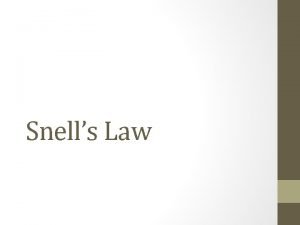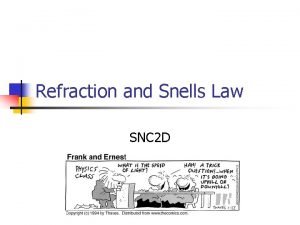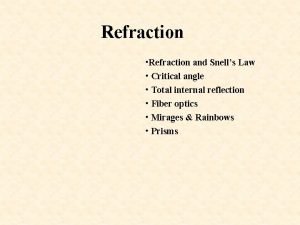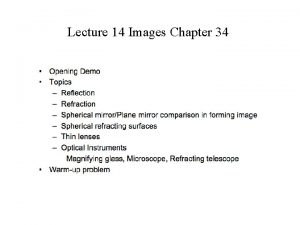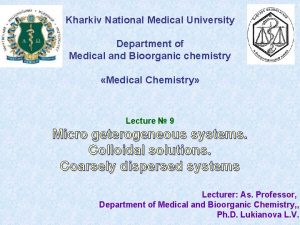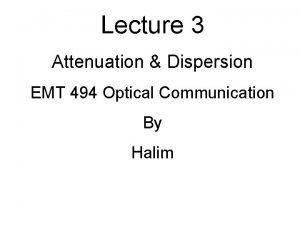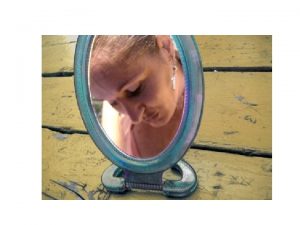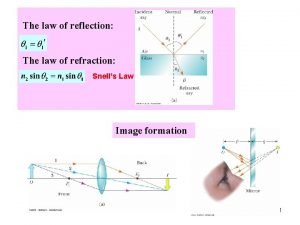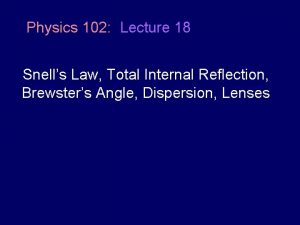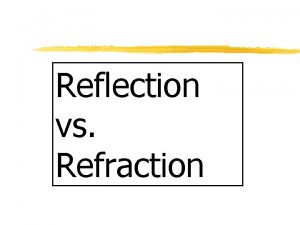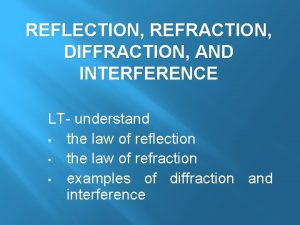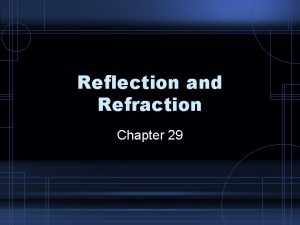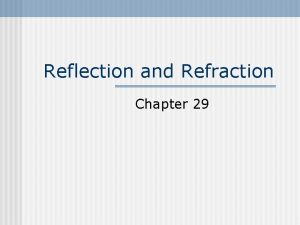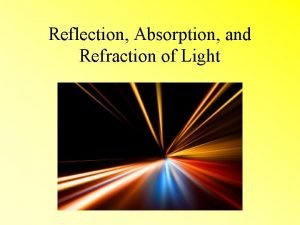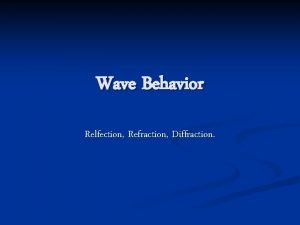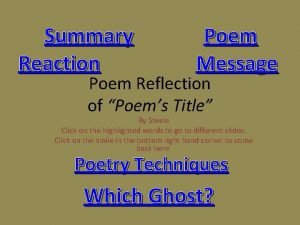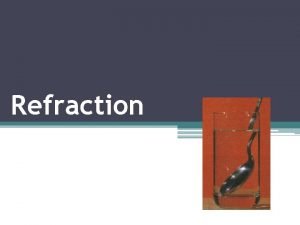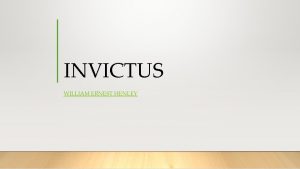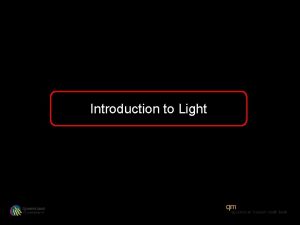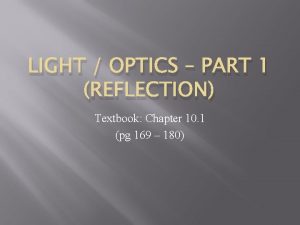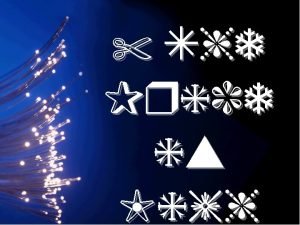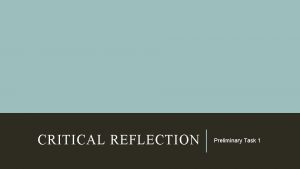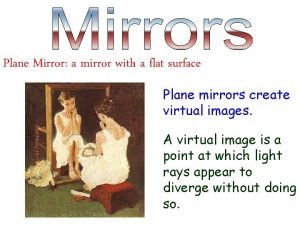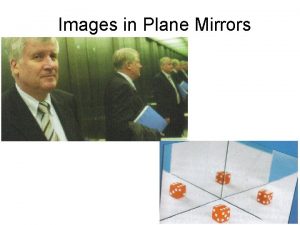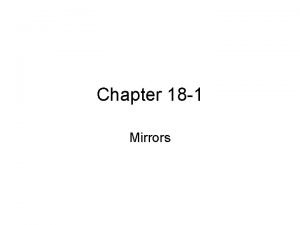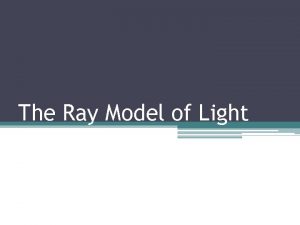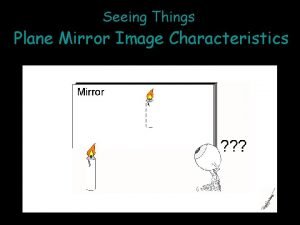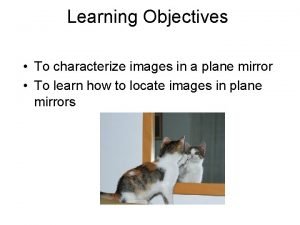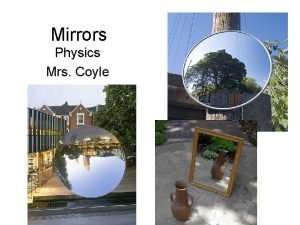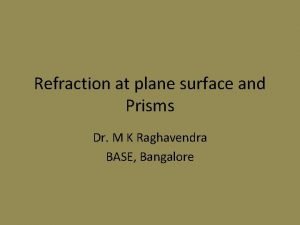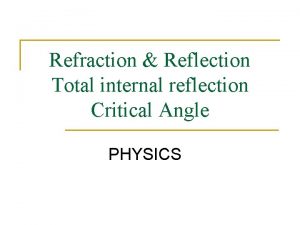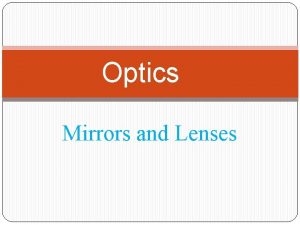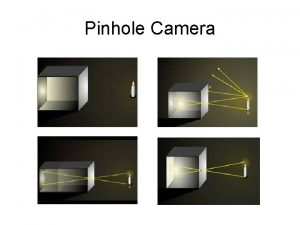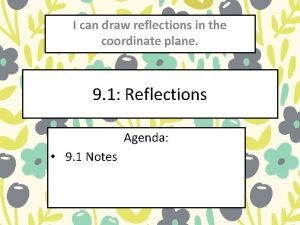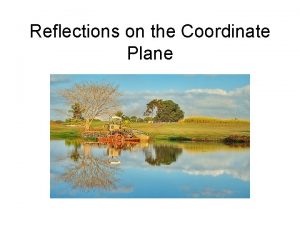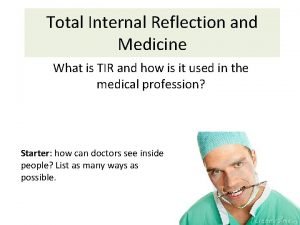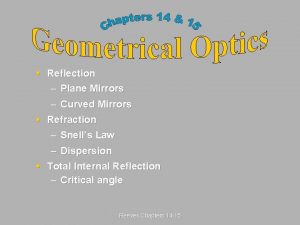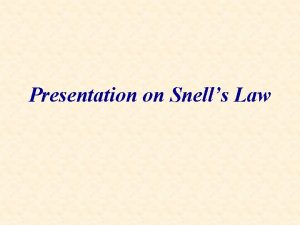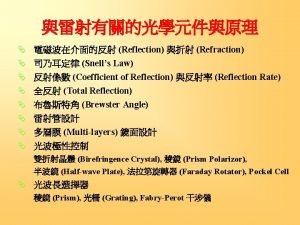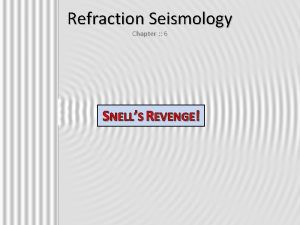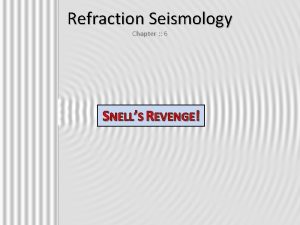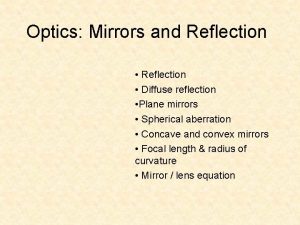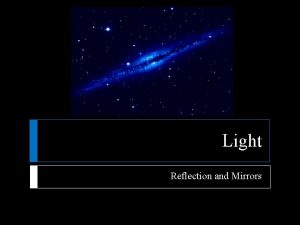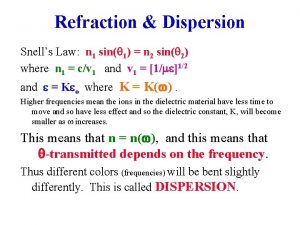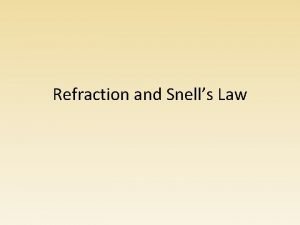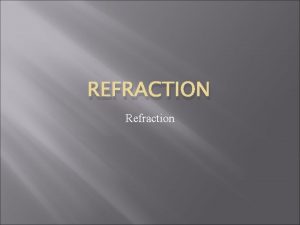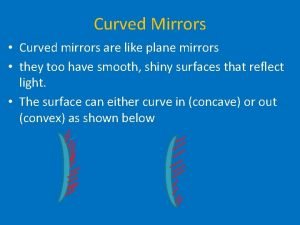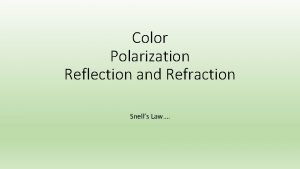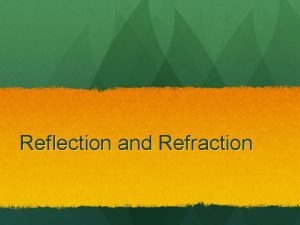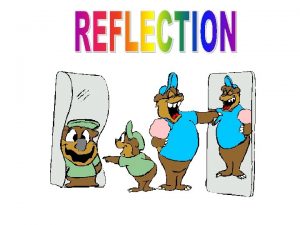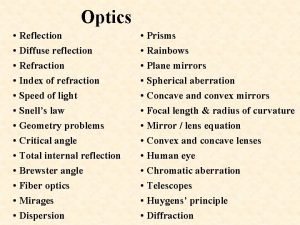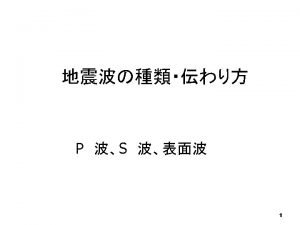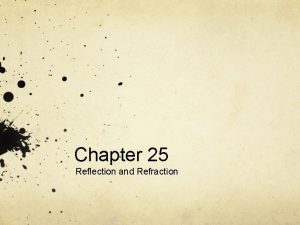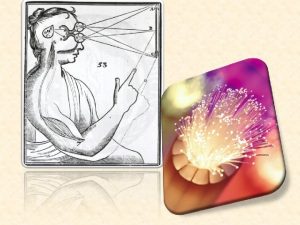Reflection Plane Mirrors Refraction Snells Law Dispersion Total












































- Slides: 44

§ Reflection – Plane Mirrors § Refraction – Snell’s Law – Dispersion § Total Internal Reflection Reeves Chapters 14 -15

Light Rays A point source of light emits spherical waves in all directions. Each circle represents a wave front or crest of a wave. Rays are: perpendicular to wave fronts point in the direction of wave travel are straight lines If we are far enough away from the light source, the spherical wave front looks flat. plane waves Note that for plane waves: wave fronts are parallel to each other rays are parallel to each other and to wave fronts Reeves Chapters 14 -15

Geometric Optics § We assume that light follows straightline paths (rays) § Changes occur when a ray hits a boundary – ray may bounce off (reflection) – ray may bend into the other medium (refraction) – ray may be absorbed (light energy thermal energy) Reeves Chapters 14 -15

Angles are Measured from the Normal In geometric optics, angles are always measured Inc ide nt ray 30 normal with respect to the normal of the interface 60 o o Reeves Chapters 14 -15 interface

Reflection Angle of incidence = Angle of reflection i = r Notice the angles are measured with respect to the normal! Reeves Chapters 14 -15

Reflection Specular reflection: smooth surface has only one good angle for reflected light to enter your eye smooth surface rough surface Diffuse reflection: rough surface has many different “angles” so reflected light can be seen at a variety of locations Reeves Chapters 14 -15

Conundrum 1(Post) 1 (1) the Moon is very large § When watching the Moon over the ocean, you often see a long streak of light on the surface of the water. This occurs because: (2) atmospheric conditions are just right (3) the ocean is calm (4) the ocean is wavy (5) motion of the Moon RESPONDEX Wireless Interactive Classroom Y N U 1 A 2 B 3 C 4 5 D E 6 7 8 9 All Done 0 Control [geoopt 1 b] Reeves Chapters 14 -15

Conundrum 1(ans) 1 (1) the Moon is very large § When watching (2) atmospheric conditions are just right the Moon over the (3) the ocean is calm (4) the ocean is wavy ocean, you often (5) motion of the Moon see a long streak When the water surface changes, the angle of light on the of incidence also changes. Thus, different surface ofcan the spots on the water reflect the Moon into water. your eyes at different times. This occurs because: Reeves Chapters 14 -15

Images § Trace rays from object to mirror to eye. – Brain assumes that light travels a This is a in “virtual” image since it does not actually exist straight line !! behind the mirror. – Extend rays back behind mirror to form image. object Reeves Chapters 14 -15

Conundrum 2(Post) 2 § An observer at point O is facing a mirror and observes a light source S. Where does the observer perceive the mirror image of the source to be mirror 3 O 1 S 2 RESPONDEX Wireless Interactive Classroom Y N U 1 A 2 B 3 C 4 5 D E 6 7 8 9 All Done 0 Control [geoopt 2 b] Reeves Chapters 14 -15 4

Conundrum 2(ans) 2 § An observer at point O is facing a mirror and observes a light source S. Where Trace the light rays from the object does the observer to the mirror to the eye. Since the brain assumes that light perceive the travels in a straight line, simply mirror image of the extend the rays back behind mirror to locate the image. the source to be mirror 3 O Reeves Chapters 14 -15 1 S 2 4

Conundrum 3(Post) 3 § You hold a hand mirror 0. 5 m in front of you and look at your reflection in a fulllength mirror 1 m behind you. How far in back of the big mirror do you see RESPONDEX Wireless Interactive Classroom Y N U 1 A 2 B 3 C 4 5 D E 6 7 8 9 All Done 0 Control [geoopt 3 b] Reeves Chapters 14 -15 (1) 0. 5 m (2) 1. 0 m (3) 1. 5 m (4) 2. 0 m (5) 2. 5 m 1. 0 m 0. 5 m

Conundrum 3(ans) 3 § You hold a hand mirror 0. 5 m in front of you and look at your reflection in a full. The image of the face reflected in thelength small mirror appears 1 0. 5 m m mirror behind the small mirror. This behind you. How image (which is the object for the bigfar mirror) 2. 0 m away from the inisback of the big mirror. So the final image is mirror do you see 2. 0 m behind the big mirror Reeves Chapters 14 -15 (1) 0. 5 m (2) 1. 0 m (3) 1. 5 m (4) 2. 0 m (5) 2. 5 m 1. 0 m 0. 5 m

Finding images for a concave (converging) mirror. R stands for the “radius of curvature” of the mirror R Center of curvature Focal point = R/2 Reeves Chapters 14 -15

Finding images for a concave (converging) mirror. Any ray parallel to the axis will be reflected through the focal point. Bend the rays at the dotted line to be consistent with the mirror equations. C Reeves Chapters 14 -15 f

Finding images for a concave (converging) mirror. Any ray through the focal point will be reflected parallel to the axis. Light is “reversible. ” Any ray passing through the focal point will be reflected parallel by the mirror. C Reeves Chapters 14 -15 f

Finding images for a concave (converging) mirror. Where would an image be for a far away object? Image is smaller than the object, inverted, and near f. This is a “real” image. Object Image C f If the object were at infinity, the image would be at the focal point but would have zero size. Note this is also true for converging lenses. Reeves Chapters 14 -15

Finding images for a concave (converging) mirror. Bring the object closer. Image is still smaller than the object (larger than before), inverted, and farther from f. Still a “real” image. Object Image C Reeves Chapters 14 -15 f

Finding images for a concave (converging) mirror. Bring the object closer yet. Image is now larger than the object, inverted, and farther yet from f. Still a “real” image. Note the difference in image position when the rays bend at the mirror. Object C f Caution: You must bend the ray at the dotted line to match the math. Reeves Chapters 14 -15

Finding images for a concave (converging) mirror. What if we place the object at the focus? Image is now at infinity, infinitely large, and really doesn’t make much sense. Object C f This is the inverse of the situation when the object was at infinity. Reeves Chapters 14 -15

Finding images for a concave (converging) mirror. What if we place the object inside the focus? But these rays do not intersect, similar to the flat mirror case. Ray drawn as if it came from f. Object C Image f Now the image is larger than the object, upright, and well behind the mirror. This is a virtual image. Reeves Chapters 14 -15

Finding images for a concave (converging) mirror. Last time, very close to the mirror. This is getting very much like the flat mirror case. Object C Image f Now the image is slightly larger than the object, upright, and nearly the same distance behind the Reeves Chapters 14 -15 mirror. This is a virtual image.

Mirror Equations: (look familiar? !) § Image location § Magnification Minus signs are important! Reeves Chapters 14 -15

Example: do = 23, f = 4 di = +4. 8 ? m = -di/do = -0. 2 meaning inverted and smaller Object Image C Reeves Chapters 14 -15 f

Refraction of Light Objects in water appear broken because light gets “bent” medium n vacuum 1. 0 air ~1. 0 water 1. 3 glass 1. 5 Why ? ? light travels slower in a c = speed in vacuum medium than in air: v = speed in medium Reeves Chapters 14 -15

Refraction of Light (Qualitative) pavement As “wave front” of soldiers marches from pavement to mud, they slow down and so the line bends. mud Wheel and axle moving from pavement to grass. Wheel moves slower on the grass, so the axle turns. slower faster >> in going from faster to slower, bend towards the normal >> wavelength also changes !! Reeves Chapters 14 -15

Refraction of Light (Quantitative) Snell’s Law: n 1 sin 1 = n 2 sin 2 Reflected ray Reeves Chapters 14 -15

More Refraction. . . How can we understand this bending of the rays? n 2 > n 1 So if v 2 < v 1 (medium #2 is slower), then 2 < 1 and the ray will bend towards the normal !! Reeves Chapters 14 -15

Conundrum 4(Post) 4 Refraction (1) medium 1 § Parallel light rays cross interfaces from air into two different media, 1 and 2, as shown in the figures below. In which ofair the media is 1 the light traveling faster? (2) medium 2 (3) both the same air RESPONDEX Wireless Interactive Classroom Y N U 1 A 2 B 3 C 4 5 D E 6 7 8 9 All Done 0 Control [geoopt 4 b] Reeves Chapters 14 -15 2

Conundrum 4(Ans) 4 Refraction (1) medium 1 § Parallel light rays (2) medium 2 cross interfaces from (3) both the same air into two different media, 1 and 2, as Theshown greater thein difference the figures How does the speed in air in the speed of light compare to that in 1 or 2 ? below. In media, which of between the two the greater the bending the media is the light air of the light rays. traveling faster? 1 2 Reeves Chapters 14 -15

Conundrum 5(Post) 5 Refraction (1) aim directly at the image § To shoot a fish with a gun, should you aim directly at the image, slightly above, or slightly below? (2) aim slightly above (3) aim slightly below RESPONDEX Wireless Interactive Classroom Y N U 1 A 2 B 3 C 4 5 D E 6 7 8 9 All Done 0 Control [geoopt 5 b] Reeves Chapters 14 -15

Conundrum 5(Ans) 5 Refraction (1) aim directly at the image § To shoot a fish with a gun, should you aim directly at the image, slightly above, or slightly below? (2) aim slightly above (3) aim slightly below Due to refraction, the image will appear higher than the actual fish, so you have to aim lower to compensate. Reeves Chapters 14 -15

Conundrum 6(Post) 6 Refraction (1) aim directly at the image § To shoot a fish with a laser gun, should you aim directly at the image, slightly above, or slightly below? (2) aim slightly above (3) aim slightly below RESPONDEX Wireless Interactive Classroom Y N U 1 A 2 B 3 C 4 5 D E 6 7 8 9 All Done 0 Control [geoopt 6 b] Reeves Chapters 14 -15

Conundrum 6(Ans) 6 Refraction (1) aim directly at the image § To shoot a fish with a laser gun, should you aim directly at the image, slightly above, or slightly Thebelow? light from the laser beam (2) aim slightly above (3) aim slightly below ligh las t fro mf er b eam will also bend when it hits the air-water interface, so aim directly at the fish Reeves Chapters 14 -15 ish

More Refraction. . . § Consider a light ray which traverses a thick slab – ray bends towards the normal upon entering the glass Reeves Chapters 14 -15 – ray bends away

Conundrum 7(post) 7 Refraction (1) shifted to the right § An observer views two closely spaced lines through an angled piece of glass. To the observer, the lines appear: (2) shifted to the left (3) spaced farther apart (4) spaced closer together (5) no change -- same as before RESPONDEX Wireless Interactive Classroom Y N U 1 A 2 B 3 C 4 5 D E 6 7 8 9 All Done 0 Control [geoopt 7 b] Reeves Chapters 14 -15

Conundrum 7(ans) 7 Refraction (1) shifted to the right § An observer views (2) shifted to the left two closely (3) (4) spaced lines (5) through an angled piece ofget glass. The light rays refracted twice, so they remain parallel, but they To the observer, shift to the left, left as seen in the appear: figure. lines Their relative spacing spaced farther apart spaced closer together no change -- same as before does not change, just the overall position. Reeves Chapters 14 -15

Total Internal Reflection § When light goes from a medium with high n into a medium with low n, rays § bend At a particular incident angle away from the normal. (critical angle c), the refracted air n ( < n ) 2 1 angle becomes exactly 90°. n 1 c water § At angles greater than c there is no refracted ray at all. The Reeves Chapters 14 -15

§ Total Internal Reflection What is the condition for total internal reflection? – when i = c refracted angle is 90° n 2 ( < n 1) n 1 90° air c water § Remember !! this only works when the incident medium has Reeves Chapters 14 -15

Refraction § A beam of light is emitted in a pool of water from a depth of 62 cm. How far away must it strike the airwater surface, relative to the spot directly above it, so that the light does not exit the water? See Problem 23 -42 Reeves Chapters 14 -15

The Visible Spectrum § Remember that white light contains all the colors of the spectrum – recall the separation of colors from Reeves Chapters 14 -15

Diffraction grating with different colors § If the light has two wavelengths, we get two sets of maxima: § If it is white light (all colors, therefore all wavelengths): Reeves Chapters 14 -15

Dispersion § n decreases as l increases – for red light (l = 700 nm) n smaller (less bending) – for blue light (l = 400 nm) n bigger (more bending) – spreading (dispersion) of colors due to refraction !! Reeves Chapters 14 -15

Rainbows are formed by dispersion § light is refracted by spherical water droplets – red light is bent at a lesser angle (top of rainbow) – violet light is bent at a greater angle (bottom of rainbow) Reeves Chapters 14 -15
 Snells law
Snells law How to find the index of refraction
How to find the index of refraction What is a critical angle
What is a critical angle Snells law
Snells law Dispersed phase and dispersion medium
Dispersed phase and dispersion medium Dispersion phase and dispersion medium
Dispersion phase and dispersion medium Attenuation fiber
Attenuation fiber Software-defined networking: a comprehensive survey
Software-defined networking: a comprehensive survey Chapter 17 reflection and mirrors
Chapter 17 reflection and mirrors Physics
Physics Snell's law critical angle
Snell's law critical angle Total internal reflection snell's law
Total internal reflection snell's law Refraction vs reflection
Refraction vs reflection Reflection refraction diffraction interference
Reflection refraction diffraction interference Cmedium
Cmedium Rainbow total internal reflection
Rainbow total internal reflection Chapter 29 reflection and refraction
Chapter 29 reflection and refraction Reflection refraction absorption
Reflection refraction absorption Reflection wave behavior
Reflection wave behavior What is your reaction of the poem
What is your reaction of the poem Partial reflection and refraction examples
Partial reflection and refraction examples Bill nye light
Bill nye light Invictus by ernest hemingway
Invictus by ernest hemingway Introduction of light
Introduction of light First light optics
First light optics Reflection refraction
Reflection refraction Venn diagram of geometric optics and physical optics
Venn diagram of geometric optics and physical optics Klews chart
Klews chart Massless bundles of concentrated energy
Massless bundles of concentrated energy Reflection and refraction learning task 1
Reflection and refraction learning task 1 It is a mirror with a flat surface.
It is a mirror with a flat surface. Image in plane mirror
Image in plane mirror Is a flat smooth mirror
Is a flat smooth mirror Clearly explain what is meant by the term geometric optics
Clearly explain what is meant by the term geometric optics Salt of plane mirror
Salt of plane mirror All images in plane mirrors are apex
All images in plane mirrors are apex Physics
Physics The refractive indices of crown glass prism for c d f
The refractive indices of crown glass prism for c d f Critical angle physics
Critical angle physics Meniscus lens ray diagram
Meniscus lens ray diagram Planes of symmetry of an equilateral triangular prism
Planes of symmetry of an equilateral triangular prism Pinhole camera reflection
Pinhole camera reflection Reflection on coordinate plane
Reflection on coordinate plane Reflections in the coordinate plane
Reflections in the coordinate plane Total internal reflection in medicine
Total internal reflection in medicine
